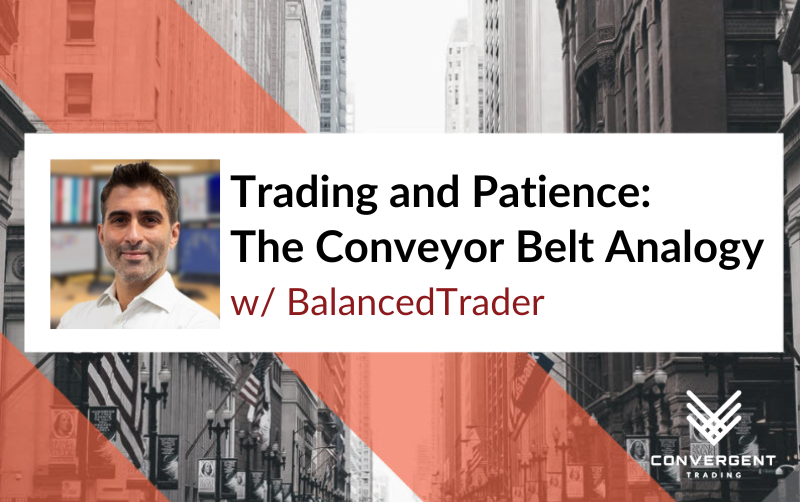Trading and Patience: The Conveyor Belt Analogy w/ BalancedTrader
For a trader, patience is not just a tool and a necessity. To illustrate this, let’s consider the analogy of a factory worker stationed at a conveyor belt. This worker’s task is simple: lift the boxes off the conveyor belt as they arrive. At all other times, any action is not only unnecessary but also inefficient.
Imagine a factory where the conveyor belt moves at a steady pace, delivering boxes at regular intervals. The worker stands ready, but only lifts the boxes when they arrive. If the worker were to fidget, move around unnecessarily, or try to lift boxes that haven’t yet arrived, it would be a waste of energy and time. The worker’s efficiency lies in their ability to wait patiently and act only when the moment is right.
The Role of Timing
In both trading and the factory scenario, timing is everything. The factory worker must lift the boxes precisely when they arrive. If they act too early or too late, they miss the opportunity. Similarly, in trading, entering or exiting a trade at the wrong time can lead to losses. Successful traders develop a keen sense of timing, understanding when to act based on market signals and conditions.
The Importance of Focus
The factory worker must stay focused on the conveyor belt, ready to lift the boxes as they come. Distractions can lead to missed boxes or mistakes. In trading, focus is equally important. Traders need to stay attentive to market trends, news, and data. Distractions can lead to missed opportunities or poor decision-making.
Similarly, in trading, the market can be likened to the conveyor belt. Opportunities (the boxes) come at their own pace. A trader must remain vigilant and ready to act, but only when the right opportunity presents itself. Acting prematurely or out of impatience can lead to mistakes and inefficiencies, just as it would for the factory worker.
Managing Emotions
Imagine if the factory worker became frustrated or anxious while waiting for the boxes. This emotional turmoil could lead to mistakes or inefficiency. In trading, managing emotions is crucial. Fear, greed, and impatience can cloud judgment and lead to impulsive decisions. Successful traders maintain emotional discipline, staying calm and composed regardless of market fluctuations.
“In trading, managing emotions is crucial. Fear, greed, and impatience can cloud judgment and lead to impulsive decisions. Successful traders maintain emotional discipline, staying calm and composed regardless of market fluctuations.“
– BalancedTrader
Efficiency and Conservation of Energy
The factory worker conserves energy by only acting when necessary. They don’t waste effort on unnecessary movements. In trading, efficiency means not overtrading. Overtrading can lead to increased transaction costs and emotional burnout. By being selective and patient, traders can conserve their resources and focus on high-probability opportunities.
Trusting the Process
Patience is also about managing expectations. The conscious mind sets high standards, but the subconscious often struggles with delayed gratification.
The conscious mind, driven by our goals and aspirations, sets high standards for achievement. In contrast, the subconscious mind—which controls our habits and impulses—often struggles with delayed gratification, finding it difficult to wait for long-term rewards.
This clash between conscious intentions and subconscious tendencies manifests in various aspects of life, from sticking to a diet to saving money or maintaining a consistent exercise routine. To bridge this gap, techniques such as mindfulness, setting smaller intermediate goals, and positive reinforcement can help align the subconscious with the conscious mind’s objectives.
The factory worker trusts that the conveyor belt will deliver the boxes at the right time. They don’t try to control the belt; they simply respond to it. In trading, it’s important to trust the process and the strategies you’ve developed. Markets can be unpredictable, but having a well-thought-out plan and sticking to it can lead to long-term success.
Just as the factory worker trusts the conveyor belt to deliver the boxes at the right time, traders must trust their process and strategies.
Learning and Adaptation
Both the factory worker and the trader must be willing to learn and adapt. The worker might find more efficient ways to lift the boxes or adjust their stance for better performance. Traders must continuously learn from their experiences, adapting their strategies to changing market conditions.
By emphasizing the process over the immediate monetary results, you can teach your mind to appreciate patience as a crucial component of your trading arsenal. The result will be a gradual increased resilience, consistency, and confidence in your approach over time, in addition to financial gains.
Conclusion
The key to success in both scenarios is patience and discipline. The factory worker trusts the process, knowing that the boxes will arrive in due time. They conserve their energy and focus, ensuring they are ready to act when needed. Traders must adopt the same mindset. By waiting for the right market conditions and signals, they can make informed decisions that maximize their chances of success.
In conclusion, whether you’re lifting boxes off a conveyor belt or making trades in the market, patience is crucial. Just as the factory worker’s productivity depends on their ability to wait for the boxes, a trader’s success hinges on their ability to wait for the right opportunities.
Patience is a tool, much like the factory worker’s readiness to lift the boxes, and it can create a powerful outcome for a trader.
BalancedTrader
CT Maven

